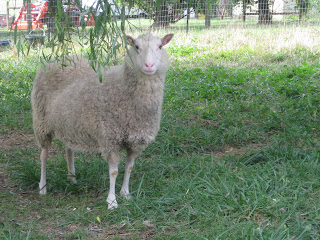This Month's Breed
The Finnsheep
Raising Finnsheep
Finnsheep were originally
developed and breed in Finland. It is considered a duel breed sheep (wool,
milk, meat). They are relatively easy to handle. Thought they are a considerably
larger sheep say than the Shetland or Icelandic sheep. Females range
in weight from 120 lbs to 160 lbs where the Males can range from 160 to 220
lbs. No docking is needed as they have a
Shetland like fluked tail. Also are hardy and can thrive on sparse forage. The Finnsheep in considered a litter baring
breed. Most breeders try to breed for ewes that are going to through 3-4 lambs that
being. The world record of numbers of lambs born was 9 and was set by a Finnsheep.
I had Finns for a time and the ewes that I had birthed 5 and 6. Very prolific!
I, personally, found myself bottle feeding some but over all a fine breed and
great fiber and good disposition.
The Fiber
A
fleece from a full grown Finnsheep should weigh between 7-12 lbs. Staple length
can vary from 3-5 inches if shorn once a year, which is the norm. The tips of the
fiber may appear slightly lockie or may taper a bit. The fiber on the sheep tends to be dense and even
if the sheep is not coated vegetable mater has a hard time getting into
the fleece if feeding is managed properly. The fiber itself is quite crimpy but can vary
from animal to animal. The standard minimum
is 8-12 per inch. The micron count is 21-35 by EU standards < 26 microns.
Finn wool should also be void of kemp and guard hairs. Finns also come in a
wide variety of colors including white, fawns, browns and blacks. Dilution occurs
when the sheep’s fiber fades as it grows older. This is where greys and other
shades of browns will occur. Unlike
some breeds Finnsheep do not have excessive amounts of lanolin. Raw fibers in
the hand should seem Soft
and silky in addition have a semi-lustrous appearance to them.
Processing and Spinning Finn Fleece.
 Since Finn fiber does not have too much lanolin it has a tendency to wash up fairly easily. I used 140 degrees F water one wash and 2 rinses and it looks great. I did find that my 10oz washed, when dried were then 7oz, Standards state “70% Clean Yield Percentage”. That was a perfect match. Once fiber is washed, carding is practically effortless. The sample that I spun was uncarded. I was able to flick fiber by hand as I spun it. Much of the vegetation that was in this particular fleece fell out. For a cleaner end product I would recommend first carding with hand cards or a drum carder. Nice loft to the yarn
Since Finn fiber does not have too much lanolin it has a tendency to wash up fairly easily. I used 140 degrees F water one wash and 2 rinses and it looks great. I did find that my 10oz washed, when dried were then 7oz, Standards state “70% Clean Yield Percentage”. That was a perfect match. Once fiber is washed, carding is practically effortless. The sample that I spun was uncarded. I was able to flick fiber by hand as I spun it. Much of the vegetation that was in this particular fleece fell out. For a cleaner end product I would recommend first carding with hand cards or a drum carder. Nice loft to the yarn
Try some yourself @ our ETSY STORE




